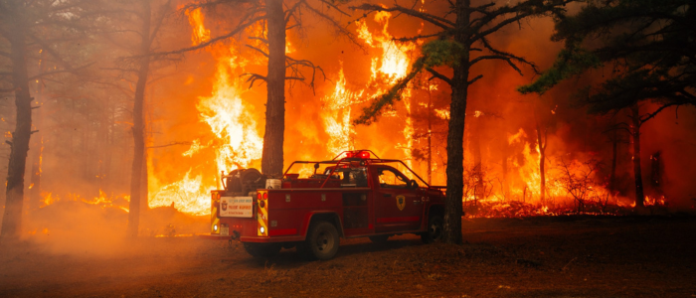by Alison Mitchell, Executive Director, New Jersey Conservation Foundation
The second largest New Jersey wildfire in 20 years broke out in Lacey Township, Ocean County on April 22, 2025. Started by an illegal bonfire west of the Garden State Parkway, the Jones Road Fire burned over 15,000 acres of the Pine Barrens, including much of the Forked River Mountains. Although the fire caused the evacuation of thousands of homes and destroyed several outbuildings and vehicles, thankfully no one was injured and no houses were destroyed.
The sparing of local residents and homes in this fire was no happy accident. Land use in this area of the state has long been guided by the Pinelands Comprehensive Management Plan. That plan, created under the Pinelands Preservation Act, directs homes and businesses to growth areas and maintains much of the landscape as undeveloped. That planning has worked hand in hand with the permanent preservation of many thousands of acres of fire-prone areas – protecting a globally rare ecosystem and keeping people out of harm’s way.
“The State of New Jersey’s long-standing commitment to acquiring and preserving open space, including in the Pinelands, plays an important role in wildfire protection in that conserved lands, when properly managed, provide a critical buffer at the wildland-urban interface – the area where wildland vegetation meets human development,” said Shawn M. LaTourette, the state’s Commissioner of Environmental Protection (DEP).
The Pinelands has over 800,000 acres of forest, and about half is permanently preserved. Due to planning and land conservation efforts, and the service and skill of the New Jersey Forest Fire Service and its use of fire breaks, residents have been spared devastating losses in a fire-prone region. “Thanks to over 60 years of open space acquisitions made possible by DEP’s Green Acres Program, Ocean County’s Open Space Trust Fund, and the efforts of numerous nonprofit organizations, the Pinelands is largely free from development,” said LaTourette.
Wildfires are an essential component of Pine Barrens ecology, and spring is typically peak fire season in this pine and oak dominated landscape. Pine trees cast relatively little shade, and oak species don’t leaf out until mid-May, so the forest floor stays sunny and warm. Relative humidity is generally low and windy days are common. The combination of these factors means that Pine Barrens uplands dry out quickly. The porous sandy soils in southern New Jersey don’t retain moisture for long, making it possible for a fire to spark just hours after a rainfall.
In the original Pinelands Commission Plan, this part of Ocean County was targeted for residential development. But the New Jersey Pinelands Commission – the state agency that guides land use here – re-zoned the region in the 1990s. This spurred the protection of the Forked River Mountain area and avoided the placement of hundreds of residences. And thank goodness! “Had homes been developed on the west side of the Garden State Parkway, these rapidly spreading wildfires could have caused terrible disasters,” said LaTourette.
The unusual geology and natural history of the Pine Barrens have created an island of unique biological diversity. Wildfires add nutrients into the soil and create open habitat that is vital to the special plants and animals that dwell here. The ecosystem has evolved with these conditions to become fire dependent, meaning fires are essential in maintaining characteristic habitats. Before colonial times, frequent but less intense fires in the Pine Barrens occurred roughly every five to 30 years.
But wildfire and human settlement is a dangerous combination, and people naturally view fire as a bad thing. Over the last century, fire suppression has dampened the ability of the region’s ecosystems to thrive. Though it may sound like good practice, extensive fire suppression in the Pine Barrens actually threatens the ultimate survival of plants and animals.
In fact, nothing maintains and restores the Pine Barrens better than fire. Plant communities that live in charred areas bounce back almost immediately, with the exception of Atlantic white cedar. Native Americans – the original land stewards of New Jersey – performed prescribed burns there. The Pine Barrens is a living testimony to thousands of years of evolution by fire.
“It is critical that we continue our efforts to conserve the fire-prone Pinelands ecosystem,” said LaTourette, adding that “the forest and its flora and fauna can bounce back beautifully after a fire, and they did just that after the wildfire of April 1995. The same cannot be said for development in areas with such high wildfire risk, making sound land use and management decisions all the more important.”
To learn more about fire safety, please visit the New Jersey Forest Fire Service at https://www.nj.gov/dep/parksandforests/fire/.
To learn more about how you can help preserve New Jersey’s natural resources, visit the New Jersey Conservation Foundation at www.njconservation.org or reach out to us at [email protected].


